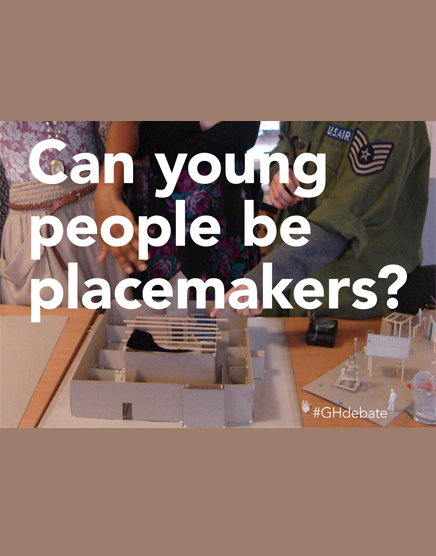Written by:
The second debate of our 2013/14 Debate Series, Place Potential, on Wednesday 20th November continued this year’s exploration by asking, “can young people be placemakers?” The response was a resounding “Yes!” from our four speakers and audience, but not without challenging questions and insights from audience and panel alike.
Kevin Franks of Regional Youth Work North East kicked off the debate with a strong affirmation that young people certainly can be placemakers – and that our task should be to explore how that can take place. Some engagement takes the easy option by engaging the usual (well-resourced, easy to work with) suspects, leaving behind young people labeled ‘disadvantaged’, ‘hard to reach’ and ‘disengaged’. Kevin raised the need for young people to have opportunities and skills to engage with society, with the caveat that with these rights come responsibilities to take on views of others and accept democratic decision-making.
Language use was explored thoroughly. Both Kevin and our second speaker Nasim Nejabat, ArchiGRAD volunteer and urban design student, raised the point that language use can create barriers to young people’s engagement by asking, “What is placemaking and what is a placemaker?” Nasim explored this further by introducing a power dimension: “Who is in charge of making place?” Her prompt answer implored that everyone who contributes to the use of a place – including young people – is a placemaker. Nasim’s experience of volunteering with a community has “changed [her] life” and inspired her to pursue a career in urban design where before she didn’t realise that she might have a job opportunity.
Another strong theme of the evening was perceptions – of people, relationships and opportunities. Our third speaker, Leah Spoor, Board Director and Volunteer at Blakelaw Ward Community Partnership, shared her experiences of how taking a leadership role as a young person within her community has affected perceptions. Leah’s proactive and respectful work with her peers and community has changed perceptions and broken down barriers between the older and younger generation on her estate: “Young people didn’t feel that they could use the community centre – but the vibe has changed so much and it’s now buzzing with young ‘uns!”
Our final speaker Dhruv Sookhoo, Head of Design at Home Group, explored why adults want young people to be involved in placemaking in the first place, stating that adults’ aspirations and values are often superimposed onto young people when they engage. This power dynamic between generations can also mean that young people are seen and used as a commodity in placemaking projects when concern for young people is used as a validating statement for the opinions of adults. Citing an example where young people were helped to what impact they might have in turning around their place Sookhoo stated: “Young people are strongest and the legacy is most profound when they’re involved in production, not consumption of place.”
With the floor open to audience thoughts and ideas, Glass-House Enabler Carinna Gebhard emphasised the need for an intergenerational approach, sharing how young people who are initially shy and intimidated can grow in confidence and resolve issues with their community through conversations around points of tension. Barbara Douglas, who supports Newcastle Elders Council, agreed wholeheartedly and added that the issues around inclusivity faced by young people are exactly the same as faced by older people in society.
It was generally agreed that there is an engagement skills and knowledge gap. Organisations leading change need to take risks to allow young people to have a real say, so that lessons can be learnt to inform future practice – but it’s hard to make happen. This needs to be complemented with a community-driven, peer-led approach where young people are upskilled to work with other young people and lead by example.
Our two young speakers and several young leaders and engaged community members in the audience are certainly leading by example – but how can we amplify the effects of the activities that take place with young people? In order to open processes up, said Nasim, “People need to know about opportunities to get involved and understand the impact their involvement will have.” But young people can initiate things too. As Leah said to the audience, “You have to take initiative. I was heard because I was determined to be heard as a resident.”
Read two responses to ‘Can young people be placemakers?’ in think pieces by Catherine Greig and Jen Marriott.
The Glass-House Debate Series 2013/14 Place Potential continues with:
- Bristol on 5 February 2014 – Should we build less and resuse more?
- London on 12 March 2014 – Can housing be a catalyst for great places?

